What’s SHIDORI

The name of the wondrous silk “SHIDORI” comes from an ancient Japanese word “倭文”(Shidori).
Shidori originally is the silk textile that would be dedicated to the God in the traditional ceremony in Japan.
It is the culture that has been inherited over generations and would be great to continue in the future.
Therefore, the brand-new silk is named as “Shidori” to commemorate the Japanese tradition and culture.
※“SHIDORI” has acquired the right of prior use under the non-exclusive license by the court.
“Authentication certificate No. 291 of Year Heisei 24”.

In general, “Washable silk” usually would go through some chemical processes such as resin coating and water-repellent process. Although it could protect the silk fiber from weathering by water, the synthetic materials such as resin on the surface would directly contact with the skin like other synthetic fibers. The specific texture of silk would also be impaired by the chemicals. Unlike these surface-processed silk, “SHIDORI” is using a new technology which specifically work on the high-quality protein (Amino Acid) molecules that present in natural silk. All the features and texture of natural silk would be preserved while the strength of the fabric is enhanced for ordinary machine washing at home. With the new technology of SHIDORI, pure silk could even be used in garments that require daily washing such as towels and underwear.
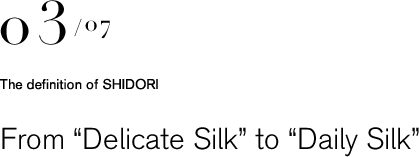
The new standards of “Washable silk” by SHIDORI
1. Resistant to discoloration (High colorfastness)
2. No resins or water repellent coating
3. Resistant to texture change
4. Limited deterioration even after washing for more than 30 times
5. Limited rate of shrinkage
With the aim of “No more hand-washing, Easy care with ordinary washing machine”, the company has strived to archive the above five points and has introduced “SHIDORI” eventually.
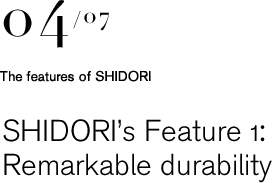
The dyeing technique of Sankaseiren obtained a high score in a recognized quality test. It scored 4 points in five testing sections including resistant to light, washing, sweat, dry cleaning and rubbing (General Average points: 3). Even for the black coloration, Sankaseiren managed to maintain a high colorfastness. When silk is used to produce clothing, the fabric would usually have to be processed with high heat or extra printing on it. Therefore only the silk with high colorfastness could be used. However, high colorfastness would require a dyeing time 5 times longer than average, and it might damage the silk fiber because of the long contact with pigments. Sankaseiren spent more than 20 year in resolving the above problems by technological research and development. With the earnest endeavor of the company, Sankeseiren succeeded in developing the high-quality silk which scored exceptionally high mark in the report by testing agency.
Colorfastness (Testing Result)
Dyed fabrics(Silk yarn was dyed before weaving into fabric)
Plain-woven(Raw silk 21/2Pied yarn × 21/3Single twist yarn For Black Color))
Testing item |
General standard |
SHIDORI Score |
|
| Resistant to light (JIS-L0842) | Above 3 |
Above 4 |
|
| Resistant to washing (JIS-L0844) | Discoloration | 4 |
5 |
| Pollution | 2-3 |
4-5 |
|
| Pollution to washing agent | - |
5 |
|
Resistant to sweat (JIS-L0848) |
Acidic - Discoloration | 4 |
5 |
| Acidic - Pollution | 2-3 |
4-5 |
|
| Alkaline - Discoloration | 4 |
5 |
|
| Alkaline - Pollution | 2-3 |
4-5 |
|
| Resistant to dry cleaning (JIS-L0860) | Discoloration | 4 |
5 |
| Pollution | 3 |
4 |
|
| Resistant to rubbing (JIS-L0849) | Dried | 3 |
4-5 |
| Wetted | 1-2 |
4 |
|
| Dimensional change rate (%) 103 method (Attack) |
Vertical | ±3 |
-0.8 |
| Horizontal | ±3 |
-0.8 |
|
| (Institute of Consumption Science ltd.) |
* The above test results are just for reference and are not guaranteed. Please be advised that the obtained data might vary with the origin of raw materials or the weaving methods etc.
2. No resin coating and water-repellent process
In general, “Washable silk” usually would go through some chemical processes such as resin coating and water-repellent process. Although it could protect the silk fiber from weathering by water, the synthetic materials such as resin on the surface would directly contact with the skin like other synthetic fibers. The specific texture of silk would also be impaired by the chemicals.
Unlike these surface-processed silk, “SHIDORI” is using a new technology which specifically work on the high-quality protein (Amino Acid) molecules that present in natural silk. All the features and texture of natural silk would be preserved while the strength of the fabric is enhanced for ordinary machine washing at home.
3. Resistant to texture change
Without resin coating or water-repellent process, silk could maintain its original luster and smooth texture. It would also be gentle to human skin.
4. Limited deterioration even after washing for more than 30 times
Ordinary silk is exceptionally fragile when dampened and therefore requires extra cares for washing. Fluff could easily appear when the silk fabric is rubbed against its surface especially when it is wetted. The luster and texture would also be impaired by the action. When silk is wetted and dried repeatedly, just like the Japanese papers, the fabric would become stiff and would eventually crack into pieces.
In contrast, the testing agency has proved that the SHIDORI Silk is having a remarkable durability and has shown its strength even higher than that of cotton. It is a proof of the high quality of SHIDORI silk.
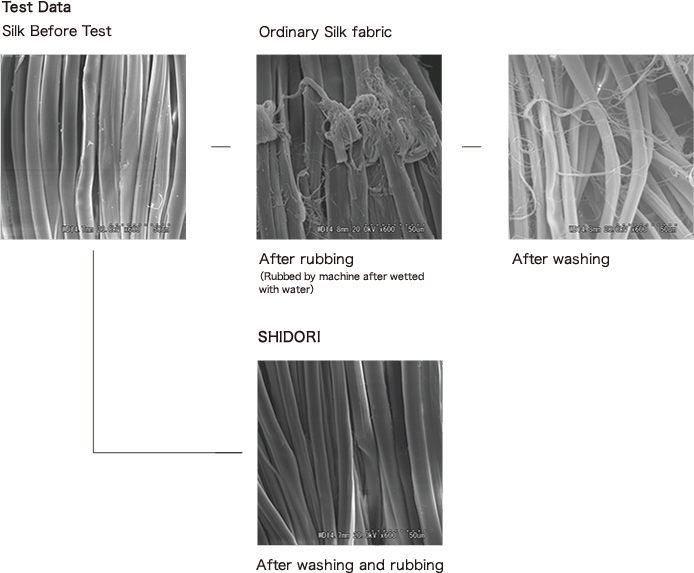
5.Limited rate of shrinkage
Silk is mainly composed of proteins and therefore vulnerable to alkali (Synthetic detergent and soap). Besides, when wetted silk is dried, the texture would turn stiff and it would cause deterioration and shrinkage of the fabric. It is shown in the test of “[4] resistant to washing” that SHIDORI successfully mitigate the hardening and shrinkage of silk after laundry.
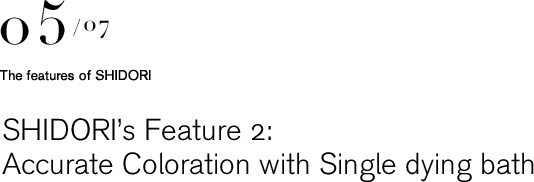
While coloration of Silk is normally done in a “Continuous dyeing bath*”, “Single dying bath” is used for SHIDORI silk. As silk is a kind of natural fibers, coloration of silks from different origins or harvest time could possibly result in different colors even using the same pigment. When the clothes are produced in bulk, it is necessary to ensure every single piece of product could be dyed into the same color. “Single dying bath” enables digitalization and reproduction of a specific color. Therefore, the same color of silk could be accurately dyed anytime according to the request of garment brands and designers, regardless of the judgment of craftsmen or the change of weather and climate. 。
*Continuous dyeing bath
“Continuous dyeing bath” is the practice which reuses dyeing fluid or pigments for different coloration. The remaining dyeing fluid from the previous coloration in the same bath would be retuned into different color and would then be used for the next coloration. This practice could reduce the amount of water used for dyeing. The number of procedures could also be reduced and therefore efficiency is enhanced. However, it is difficult to reproduce the previous same color as the dyeing fluid would be contaminated with different pigments during many times of coloration. The color produced with this method might also vary with different lighting. Therefore, “Continuous dyeing bath” is mostly applied in the coloration of Kimono which is usually tailor-made individually.

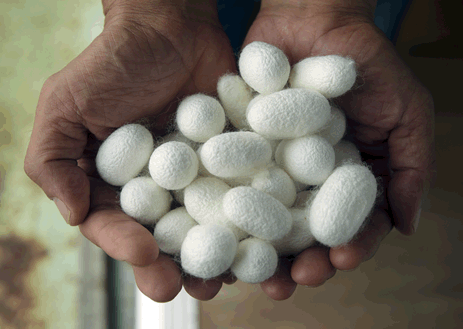
*Degumming
Degumming is the removal of the Sericin from the Silk fiber structure (Sericin and Fibroin). It could turn silk from dull white color to silvery white. It also contributes to the smoothness and drapability of the fabric.
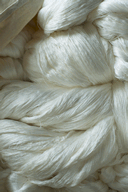
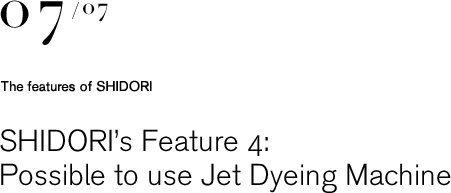
It is now possible to use Jet Dyeing Machine* to dye raw silk fabrics**. Normally, wetted silk is vulnerable to friction and fluff would appear easily when it is stirred inside the dyeing bath. So Jet Dyeing Machine could not be used for ordinary silk fabrics. However, the SHIDORI silk is strong enough to be Jet Dyed, which is a breakthrough innovation in the silk industry.
・The result of Jet Dyeing of silk could vary with techniques and methods. Please feel free to contact us for details.
*Jet dyeing is the method of coloration by keeping the fabric circulating in the current of pigment fluid. The pigment is ejected from a jet nozzle to push a circular current in the bath and therefore it is called “Jet Dyeing Machine”
** It is the plain fabric without any secondary processing such as printing, dyeing and antistatic procedures.
Dyed fabrics(Dyed in form of fabrics)
・Silk Smooth, 32Gauge, Black Jet, Dyeing Machine used
Testing item |
General standard |
SHIDORI Score |
|
| Resistant to light(JIS-L0842) | Above 3 |
Above 3 |
|
| Resistant to washing (JIS-L0844) | Discoloration | 4 |
5 |
| Pollution | 2-3 |
4-5 |
|
| Pollution to washing agent | - |
4 |
|
| Resistant to sweat (JIS-L0848) | Acidic - Discoloration | 4 |
5 |
| Acidic - Pollution | 2-3 |
4-5 |
|
| Alkaline - Discoloration | 4 |
5 |
|
| Alkaline - Pollution | 2-3 |
4-5 |
|
| Resistant to dry cleaning (JIS-L0860) | Discoloration | 4 |
5 |
| Pollution | 3 |
4-5 |
|
| Resistant to rubbing (JIS-L0849) | Dried | 3 |
4-5 |
| Wetted | 1-2 |
2-3 |
|
| Dimensional change rate (%) 103 method (Attack) |
Vertical | ±3〜−6 |
−3.9 |
| Horizontal | ±3〜−6 |
−6 |
|
| Pilling (Class) (JIS-L1076) | Vertical | 2 | 4 |
| Horizontal | 2 | 4 | |
| Frictional strength (times) (JIS-L1096 E) | 5000 times | ◯ (Normal fabric) | - (SHIDORI fabric) |
| 7500 times | ◯ (Normal fabric) | - (SHIDORI fabric) | |
| 10000 times | ◯ (Normal fabric) | ◯(SHIDORI fabric) | |
| 12500 times | ◯ (Normal fabric) | ◯(SHIDORI fabric) | |
| 15000 times | × (Normal fabric) | ◯(SHIDORI fabric) | |
・Silk milling, 24Gauge, Jet Dyeing Machine used
Testing item |
General standard |
SHIDORI Score |
|
| Resistant to light (JIS-L0842) | Above 3 |
Above 3 |
|
| Resistant to washing (JIS-L0844) | Discoloration | 4 |
5 |
| Pollution | 2-3 |
4-5 |
|
| Pollution to washing agent | - |
4 |
|
| Resistant to sweat (JIS-L0848) | Acidic - Discoloration | 4 |
5 |
| Acidic - Pollution | 2-3 |
4-5 |
|
| Alkaline - Discoloration | 4 |
5 |
|
| Alkaline - Pollution | 2-3 |
4-5 |
|
| Resistant to dry cleaning (JIS-L0860) | Discoloration | 4 |
5 |
| Pollution | 3 |
4-5 |
|
| Resistant to rubbing (JIS-L0849) | Dried | 3 |
4-5 |
| Wetted | 1-2 |
2-3 |
|
| Pilling (Class) (JIS-L1076) | Vertical | 2 | 4-5 |
| Horizontal | 2 | 4-5 | |
| Bursting strength (JIS-L1096 A) | Before washing | 300 | 468 |
| After washing 30 times (Attack) | - | 436 | |
| After washing 30 times (Emal) | - | 459 | |
・Crepe fabric, Black, Jet Dyeing Machine used
Testing item |
General standard |
SHIDORI Score |
|
| Resistant to light(JIS-L0842) | Above 3 |
Above 3 |
|
| Resistant to washing (JIS-L0844) | Discoloration | 4 |
5 |
| Pollution | 2-3 |
4-5 |
|
| Pollution to washing agent | - |
3 |
|
| Resistant to sweat (JIS-L0848) | Acidic - Discoloration | 4 |
5 |
| Acidic - Pollution | 2-3 |
4-5 |
|
| Alkaline - Discoloration | 4 |
5 |
|
| Alkaline - Pollution | 2-3 |
4 |
|
| Resistant to dry cleaning (JIS-L0860) | Discoloration | 4 |
5 |
| Pollution | 3 |
4-5 |
|
| Resistant to rubbing (JIS-L0849) | Dried | 3 |
4-5 |
| Wetted | 1-2 |
3-4 |
|
| Dimensional change rate (%) 103 method (Attack) |
Vertical | ±5 |
−0.5 |
| Horizontal | ±5 |
0.0 |
|
| 103 method (Emal) | Vertical | ±5 | −1 |
| Horizontal | ±5 | 0.0 | |
| Dimensional change rate (%) 105 method (Attack) |
Vertical | ±5 | −0.5 |
| Horizontal | ±5 | 0.0 | |
| 105 method (Emal) | Vertical | ±5 | −0.3 |
| Horizontal | ±5 | +0.2 | |
| Pilling (Class) (JIS-L1076) | Vertical | 2 | 5 |
| Horizontal | 2 | 5 | |
| Frictional strength (times) (JIS-L1096 E) | 5000 times | ◯ (Normal fabric) | - (SHIDORI fabric) |
| 7500 times | × (Normal fabric) | - (SHIDORI fabric) | |
| 10000 times | × (Normal fabric) | ◯ (SHIDORI fabric) | |
| 12500 times | × (Normal fabric) | ◯ (SHIDORI fabric) | |
| 15000 times | × (Normal fabric) | ◯ (SHIDORI fabric) | |
The above test results are just for reference and are not guaranteed.
Please be advised that the obtained data might vary with the origin of raw materials or the weaving methods etc.